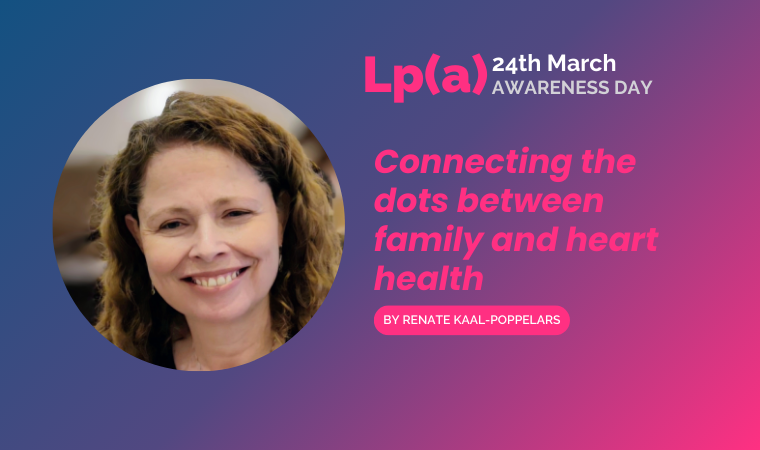
Years ago, after giving birth with pre-eclampsia, I had to push to get my blood pressure checked afterwards. Looking back, I wonder if my pre-eclampsia was already a signal of my hereditary elevated Lp(a) at the time. It’s now thought that these two may often occur together, a quiet warning I missed back then.
It turned out I had developed chronic hypertension, and once again, I had to push to get it under control with medication. I’m grateful I did. At the time, I didn’t realise just how much it increased my risk of future cardiovascular disease (CVD). But taking my high blood pressure seriously after pregnancy turned out to be one of the best decisions I could have made for my health. That experience taught me how important it is to recognise and manage risk factors early.
Life has a funny way of connecting the dots, like meeting my husband at university when I was 19 and he was 18. We both signed up for courses, but I also signed up for him. What I didn’t know then was that heart health would become such a big part of our future.
Edwin has familial hypercholesterolaemia (FH), specifically heterozygous FH (HeFH), which runs strongly in his family. FH is an inherited lipid condition and a significant risk factor for cardiovascular disease. HeFH is the most common form of FH, affecting approximately 1 in 250 to 300 people worldwide. His father was once told he likely wouldn’t live past 50. When Edwin was diagnosed at 18, statins were just starting to make a difference. Thankfully, treatments have only improved since then.
When it came time to test our children, I was nervous but hopeful. Thankfully, neither inherited FH, but our son Aedan was found to have elevated Lp(a), something I’d never even heard of. I got tested too, and just like that, more pieces of my own story fell into place.
I thought of my dad. He died of a heart attack when I was just 30. Back then, it was called “bad luck.” But knowing what I know now, it seems likely that this hidden, inherited risk was quietly there all along.
That’s the thing about elevated Lp(a): it often stays invisible until heart disease has already happened. But with better awareness and early testing, we can change the story.
Why early detection matters
Without Edwin’s FH, Aedan and I might never have been tested. Our family’s story is proof of why early screening for inherited conditions like FH and Lp(a) matters so much. We’ve seen firsthand what a difference early diagnosis and the right treatment can make. Today, Edwin leads a healthy, active life. His father, once given a dire prognosis, is turning 80 this year. And he’s still going strong.
Knowing my increased cardiovascular risk, I’ve made deliberate lifestyle changes, improving my diet, exercising, managing my blood pressure, and lowering my LDL cholesterol. These are the things that help me feel confident about my health journey.
But it’s not just about better health. Cardiovascular disease costs the EU an estimated €282 billion annually in healthcare expenses and lost productivity. Early detection of FH and high Lp(a), combined with the right care, doesn’t just save lives, it helps reduce these costs.
Life keeps moving, and our health changes with it. Sometimes in ways we expect, and sometimes in ways that catch us by surprise. I even ended up with braces recently, which my children find endlessly amusing. But whether it’s visible changes like that, or the quieter ones happening inside our bodies, it’s a reminder that looking after our health is never a one-time thing.
And sometimes, no matter how closely you pay attention, things still slip through the cracks.

When your heart doesn’t play by the rules
I was recently diagnosed with INOCA (a condition causing reduced blood flow to the heart, not because of blocked arteries, but due to problems in the small vessels and spasms) after years of searching for answers. It took five cardiologists before I finally got the right diagnosis. For years, I experienced symptoms that slowly got worse. I've had painful experiences with ER visits, the local hospital, and specialists who primarily focus on male heart health and large vessels, while my smaller vessels were the true source of the problem.
My experience as a patient ambassador for the FH Europe Foundation has helped me speak up for myself, but the journey has been incredibly difficult and, at times, soul-crushing.
And I know I’m not alone in that. Women’s hearts are different, yet men’s remain the standard in cardiology. Despite progress, cardiologists in the Netherlands, and in many other countries, are still not required to study women’s cardiology. As a result, symptoms in women are often labelled “atypical”, simply because diagnostic frameworks were built around men.
No matter who you are, when you enter the ER, you take on the role of a patient, and sadly, you can be dismissed or misdiagnosed, especially women with heart conditions. Awareness and education are crucial to changing that.
And sometimes I wonder... maybe it’s no coincidence that I live with both elevated Lp(a) and INOCA. Science hasn’t connected those dots yet, but knowing how both quietly affect the vessels, I wouldn’t be surprised. Then again, I could be wrong.
What I do know for sure is that my story is just one of many. We all deserve to be seen, heard, and properly cared for.
Bringing hidden risks into the light
I never thought elevated Lp(a) would be part of my story. Knowing about it gives you the chance to stay ahead of the risks, take action, and have informed conversations with your doctor.
A single blood test can tell you your Lp(a) level. Unlike cholesterol, it stays constant throughout your life. If it’s elevated, it stays elevated. Yet most people have never even heard of it, even though 1 in 5 people worldwide have elevated levels.
That’s why testing matters. Early detection gives you and your doctor a clearer picture of your overall cardiovascular risk. And if your Lp(a) is high? Then it becomes even more important to manage the risk factors you can control, like your LDL cholesterol, blood pressure, smoking, and making healthy lifestyle choices.
Even though European clinical guidelines recommend Lp(a) testing for people with moderate to high cardiovascular risk, it’s still not widely included in national health policies across Europe. And globally, there’s even more work to do.
This is exactly why we need Lp(a) Awareness Day on 24 March. Because awareness is the first step towards change.
That’s why I’m excited about the upcoming Lp(a) Global Summit 2025 in Brussels. It will bring together experts, policymakers, and patient advocates to finally put Lp(a) on the global agenda and push forward better policies, research, and care.
And while we're here, please learn about INOCA, ANOCA, and MINOCA. These forms of heart disease don’t always show blocked arteries. Instead, they involve spasms, small vessel problems, or heart attacks without the usual blockages. They’re especially common in women, but far too often overlooked.
That needs to change.
Let’s make sure no risk stays hidden.
For ourselves. For our families. For future generations. 💙
👉 Learn more about INOCA, ANOCA, and MINOCA:
https://vrouwenhart.nl/category/coronaire-vaatdysfunctie/
https://inocainternational.com/
https://www.internationalheartspasmsalliance.org/
Prepared by: Renate Kaal-Poppelaars